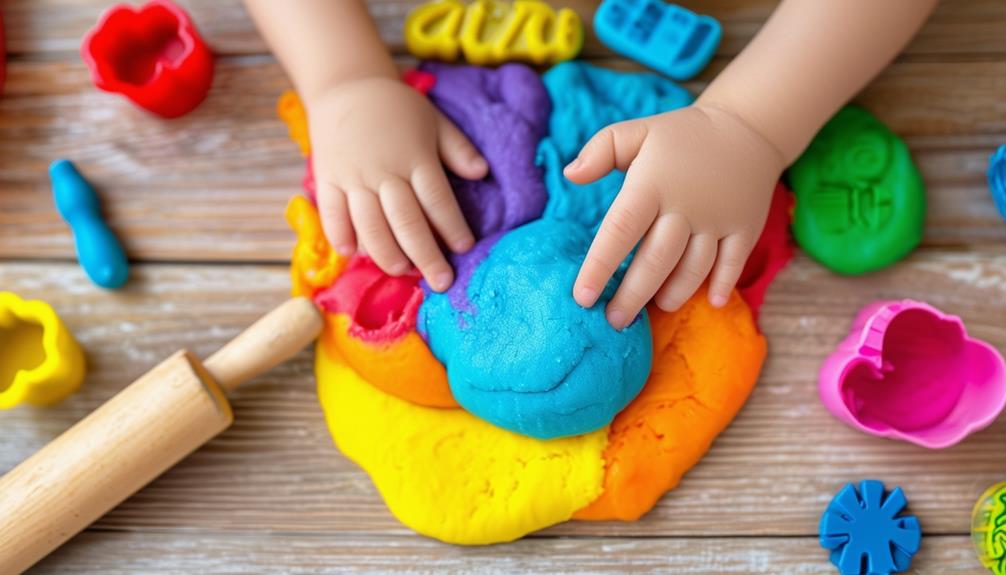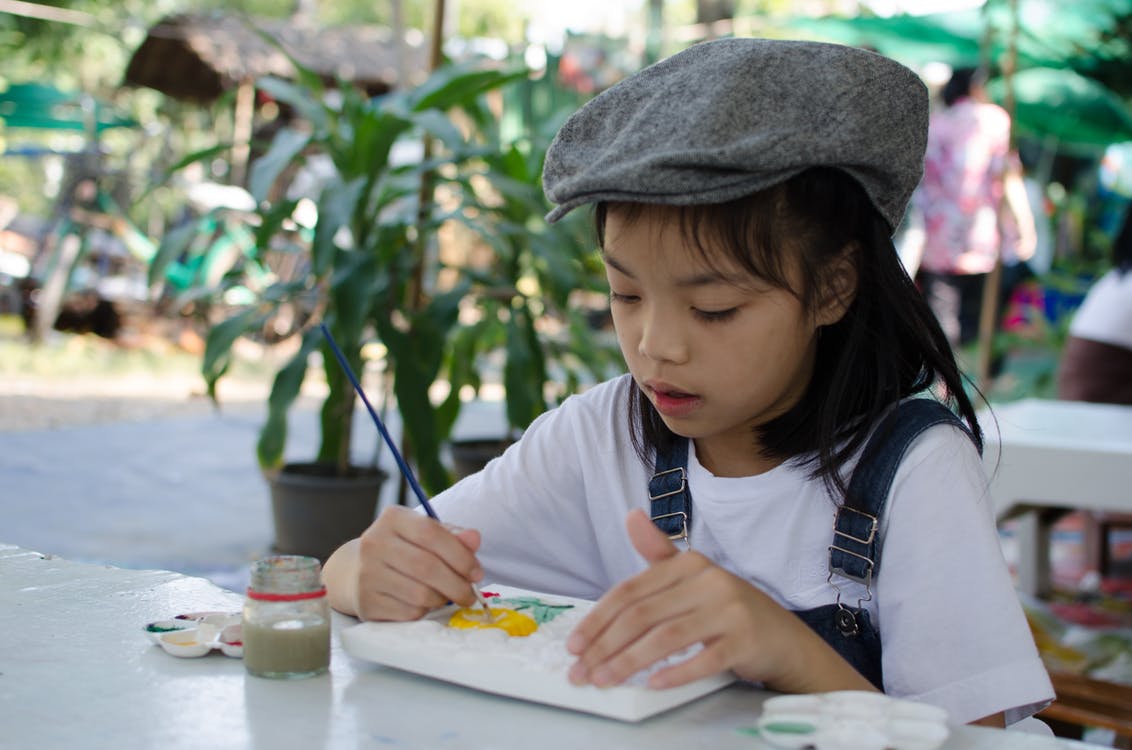10 Easy Painting Ideas for Toddlers
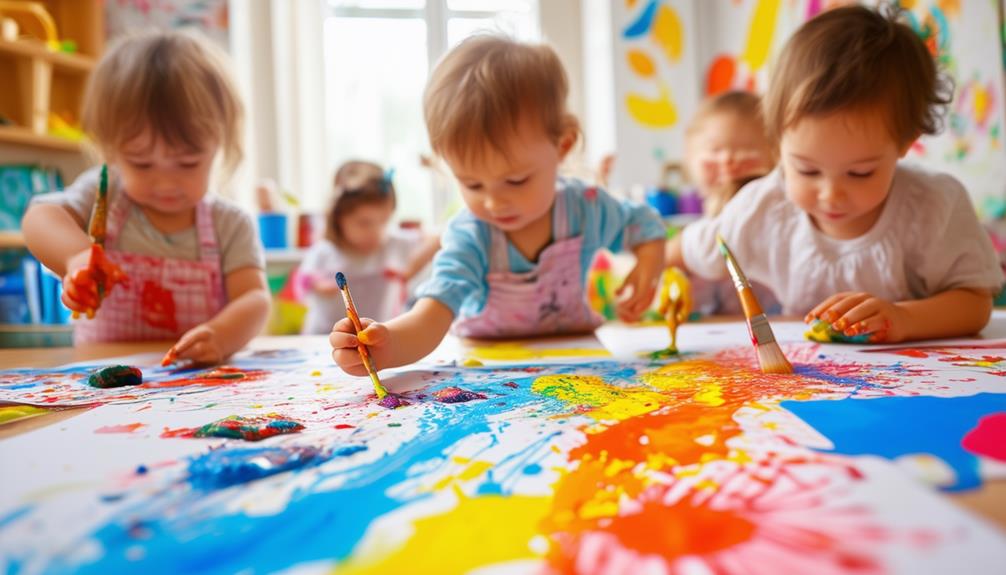
Encouraging your toddler's creativity doesn't have to be complicated or messy. With just a few basic materials, you can introduce them to painting in a way that's both enjoyable and educational. Imagine their delight as they create vibrant rainbows with a sponge or experiment with ice painting on a warm day. These activities not only nurture artistic expression but also help develop fine motor skills and cognitive abilities. Curious about how to get started with these engaging, simple painting ideas? Let's explore some inventive techniques that will keep your little one entertained and learning.
Water Pistol Painting
Water pistol painting is a delightful way for toddlers to combine playtime with creative expression. By filling water pistols with non-toxic, washable paint, you can turn a typical outdoor activity into a vibrant art session. This engaging painting activity not only entertains children but also aids in developing their fine motor skills. As they aim and spray, they practice coordination and control, which are vital components of motor skill development.
Picture setting up a large sheet of paper or canvas in your backyard and watching your child's face light up as they create colorful splatters and patterns. This form of art exploration allows toddlers to experiment with colors and shapes, fostering their artistic expression. They can see the immediate results of their actions, which is both satisfying and educational.
Water pistol painting is an inclusive activity that is suitable for all children. It's a safe and mess-friendly way to let your child's creativity flow freely, with easy clean-up since it's done outdoors. So, grab some water pistols, fill them with paint, and let your toddler embark on a fun-filled, artistic journey!
Paint a Rainbow
Creating a rainbow with your toddler is a joyful and educational activity that brings vibrant colors to life. Using the Rainbow Sponge technique, painting becomes a delightful experience that even the youngest artists can master. This method allows toddlers to create beautiful rainbows effortlessly, encouraging their creativity and enhancing their fine motor skills.
Start by gathering a sponge and some paint in rainbow colors. Dip the sponge in the paint, ensuring each section is coated in a different color. Then, show your toddler how to press the sponge onto a piece of paper, creating a stunning rainbow with a single swipe. This hands-on activity is perfect for introducing basic color concepts, as your child can see how each color blends and stands out.
The Rainbow Sponge technique doesn't just produce beautiful artwork; it also provides an engaging and fun experience for your toddler. They'll enjoy the tactile sensation of working with the sponge and the visual delight of seeing the rainbow appear. Plus, it's a simple and mess-free way to discover painting, making it an ideal project for young children. So grab a sponge, some paint, and let your toddler's creativity shine!
Ice Painting

Ice painting is a wonderful way to engage toddlers in sensory play while they enjoy the cool touch of ice and vibrant colors. To set it up, freeze water mixed with food coloring in ice cube trays. Let your child experiment with different color combinations, creating unique and colorful artwork.
Sensory Exploration Benefits
Engaging in ice painting offers toddlers a unique and invigorating sensory experience. This activity immerses them in sensory exploration, allowing them to feel the chill of the ice and observe the vibrant colors mix and spread. Through ice painting, toddlers enhance their sensory development via a hands-on, enjoyable, and educational experience.
As they dab, swipe, and smear the melting ice on paper, toddlers are not just creating art; they are engaging in creativity and experimentation. They learn about cause and effect by observing how the ice melts and colors blend, encouraging them to think creatively and try new techniques in a playful and safe environment.
Ice painting is suitable for toddlers and even babies, providing a refreshing twist to traditional painting. It offers a safe way to experiment with textures and temperatures, fostering curiosity and fine motor skills. Watching the ice melt and transform into colorful patterns can be mesmerizing and calming, making ice painting an excellent tool for sensory exploration and creative growth.
Simple Setup Instructions
To set up ice painting for your toddler, you'll need an ice cube tray, water, food coloring, and popsicle sticks. Fill the tray with water and add a few drops of food coloring to each compartment to create vibrant colors. Insert a popsicle stick into each compartment, then freeze the tray for a few hours until the ice cubes are solid.
Once the ice cubes are ready, cover a table with a plastic tablecloth or some old newspapers to keep things tidy. Arrange the colored ice cubes on a tray or a large sheet of paper, and let your toddler explore this simple art activity. The cold sensation of the ice combined with the bright colors creates a fun sensory experience perfect for little hands.
As your toddler paints with the melting ice, they'll create unique artwork that blends vibrant colors creatively. This setup encourages them to engage their senses and explore textures and temperatures, making it an enjoyable and educational painting activity. Plus, it's a refreshing activity perfect for warm days!
Engaging Color Combinations
Watching your toddler experiment with different color combinations as they create their icy masterpieces is a delightful experience. Ice painting is an excellent sensory activity that allows toddlers to explore the cool sensation of ice while playing with vibrant colors. To get started, simply freeze water in a shallow tray or ice cube molds to create your ice canvas. Once frozen, provide your child with various colored paints to dab onto the ice.
As your toddler swirls and blends the colors, they will be fascinated by how the hues mix and melt. This visually captivating activity also promotes the development of fine motor skills. Using brushes or droppers to apply paint to the slippery surface requires concentration and coordination, which are crucial for toddlers' growth.
The sensory aspect of ice painting is particularly engaging. Your child can feel the coldness of the ice and observe how the colors change as the ice melts. This hands-on activity is both fun and educational. Additionally, it's a refreshing way to spend time on hot days. Gather your paints and ice canvas and let your toddler's creativity flow in this cool and colorful activity!
Edible Paint
Edible paint provides a safe and enjoyable way for toddlers to explore their artistic side while engaging their senses. Unlike traditional paints, edible paint ensures that your child can express their creativity without any risk. This homemade solution, made from simple ingredients like flour, water, and food coloring, offers a secure and stimulating sensory play experience.
Creating edible paint at home is straightforward. Mix flour and water until smooth, then add a few drops of food coloring to achieve vibrant colors. This homemade paint is ideal for toddlers who are still learning not to put everything in their mouths. It allows them to safely experiment with different textures and colors, introducing them to the joy of painting without any concerns.
Edible paint not only ensures safety but also fosters creativity. Your child can explore their artistic abilities freely, knowing the materials are entirely safe. It's an excellent way to combine sensory play with artistic exploration, making it both fun and educational.
Paper Towel Painting
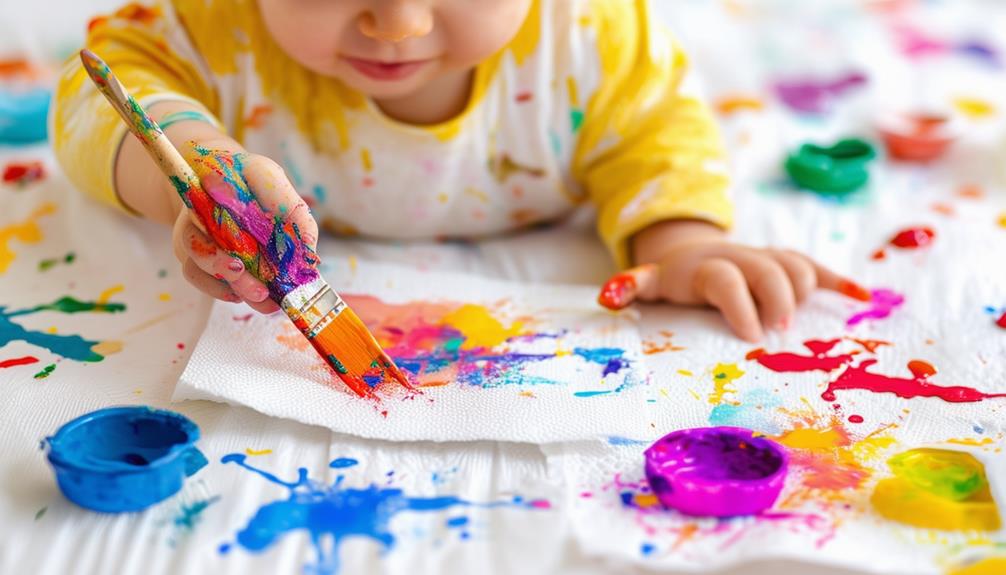
Paper towel painting offers toddlers a unique and engaging way to explore textures and colors. This activity introduces them to a textured surface that feels different from typical paper, making it a distinctive painting experience. The absorbent properties of paper towels allow toddlers to experiment with how colors spread and blend, adding an extra layer of fascination to their creative process.
Encouraging creativity, paper towel painting lets toddlers experiment with diverse colors and techniques. The texture of the paper towel can create interesting patterns and effects that standard paper can't replicate. This makes it especially perfect for holidays or themed projects, where a bit of extra texture can make the artwork stand out even more.
One of the best aspects of paper towel painting is how mess-free it can be. The absorbent nature of the paper towel helps to contain spills, making cleanup a breeze. You won't have to worry about paint splatters all over the table or floor, which is always a plus when working with young children. Overall, paper towel painting is a fun, creative, and easy-to-manage activity that your toddler will love.
Cotton Bud Painting
Cotton Bud Painting is an ideal activity for toddlers, as the small tools are easy for their little hands to hold. This activity encourages them to experiment with various tools, creating unique patterns and textures. It's simple to set up and mess-free, allowing the focus to remain on creativity.
Perfect for Little Hands
Cotton Swab Art is an excellent method for toddlers to explore their creativity while enhancing fine motor skills. This engaging activity involves using cotton swabs to apply paint to paper, offering a blend of fun and educational benefits. By manipulating these small tools, your child will improve their fine motor skills, which are crucial for tasks such as writing and dressing.
Toddlers thrive in creative projects, and cotton swab art is a fantastic addition to their repertoire of activities. The small size of the cotton swabs makes them ideal for little hands, allowing children to easily create detailed lines and shapes. This technique promotes artistic expression as kids experiment with colors and designs, fostering a creative mindset.
One of the most attractive aspects of cotton swab art is its minimal mess. Unlike other painting techniques that can result in splatters and spills, this method keeps the mess to a minimum. You can easily set up a cotton swab art station, letting your child dive into a world of imaginative fun without worrying about extensive cleanup afterward. Cotton Swab Art truly makes art accessible and enjoyable for young children.
Experiment With Different Tools
Encourage your toddler to explore their artistic side by trying out cotton buds, a delightful tool for creating unique and vibrant artwork. Cotton bud painting is not only an excellent activity for kids but also a great way to help them practice fine motor skills. This technique allows toddlers to effortlessly experiment with different lines, shapes, and patterns.
Using cotton buds, your child can dip them into various colors of paint and create beautiful designs on paper. The small size of cotton buds is perfect for little hands, providing better control and fostering independence in their creative process. Additionally, cotton bud painting is surprisingly mess-free, making it convenient for both toddlers and parents.
Consider encouraging your toddler to:
- Experiment with colors: Mix and match to see how colors blend.
- Create shapes: From circles to triangles, let them discover geometry.
- Design patterns: Encourage repetitive designs to develop consistency.
- Practice fine motor skills: The precision required helps improve hand-eye coordination.
Flour Paint
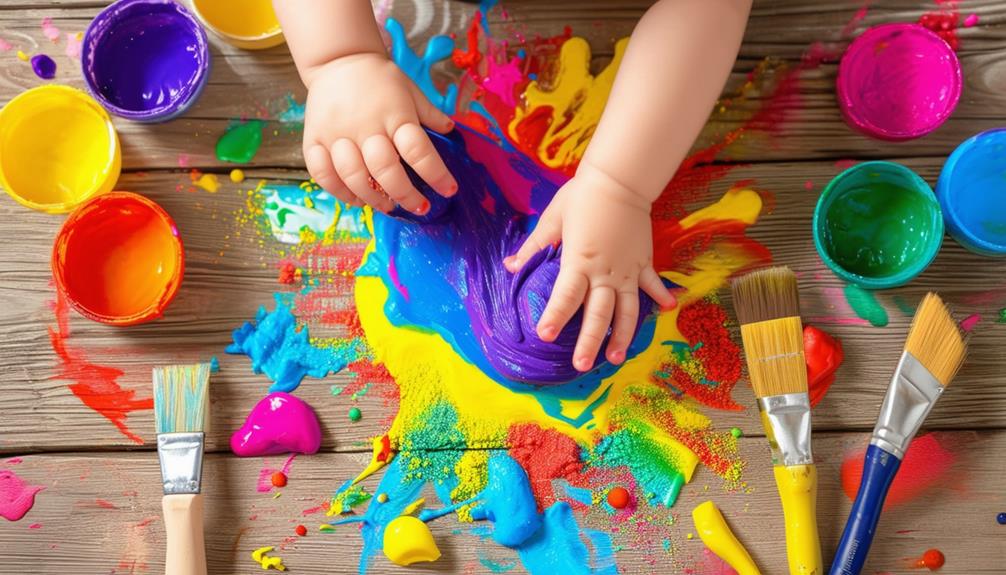
Creating flour paint at home offers a safe and enjoyable way for young children to explore their creativity. Made from simple ingredients like flour, water, and food coloring, flour paint is a taste-safe option that's perfect for toddlers and infants. Because it's non-toxic, parents can rest easy knowing that accidental ingestion poses no harm. This makes flour paint an excellent choice for sensory painting, allowing children to freely explore textures and colors.
Crafting flour paint is straightforward and budget-friendly, making it an ideal activity for parents seeking cost-effective yet engaging creative outlets. To make it, simply mix flour and water to achieve your desired consistency, then add a few drops of food coloring. You can even involve your child in the mixing process for added fun.
This DIY paint encourages creativity and artistic discovery, providing a safe environment for your child to experiment. It's a wonderful way to let toddlers dive into the world of art while ensuring their well-being. Gather your materials and enjoy watching your child delight in hours of safe, sensory-rich painting with flour paint.
Washable Window Paint
Creating vibrant and temporary window art is easy and fun with washable window paint that you can make at home. This paint is ideal for toddlers, allowing them to engage in creative activities without the worry of permanent stains. You can create this simple DIY project using just a few household ingredients: washable paint, dish soap, and flour. This mixture adheres well to glass surfaces and makes clean-up a breeze.
Here are some reasons why washable window paint is a fantastic choice:
- Safe and Non-Toxic: Using washable paint ensures it's safe for toddlers, minimizing health concerns.
- Easy Clean-Up: The dish soap in the mix allows the paint to wash off windows effortlessly with water.
- Encourages Creativity: Painting on windows provides a novel canvas, sparking your child's imagination.
- Versatile: This DIY project can be customized with different colors and textures, offering endless creative possibilities.
Incorporating washable window paint into your toddler's art time fosters creativity while keeping your home mess-free. Give it a try and watch your little artists flourish!
Handprint Fall Tree
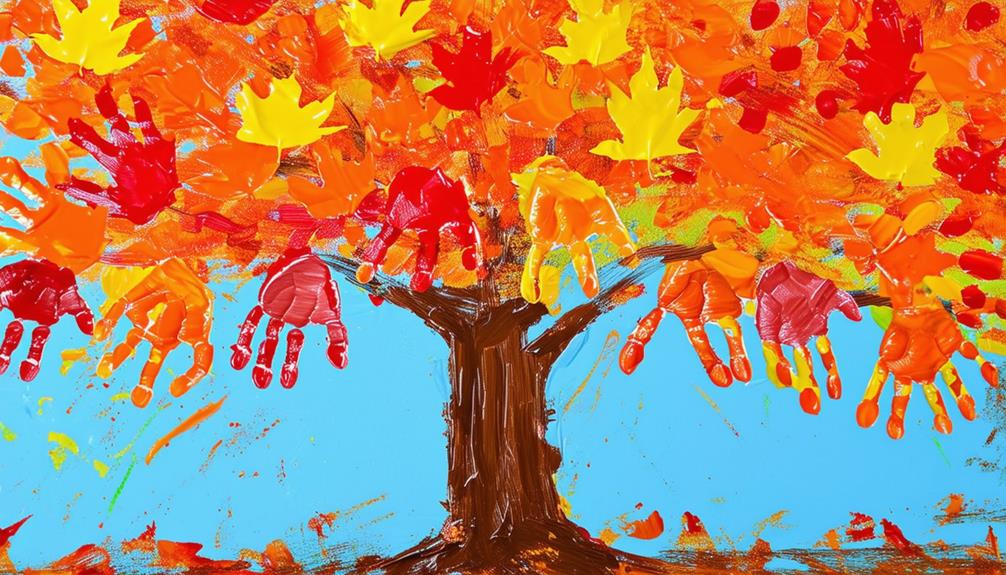
Let's create a Handprint Fall Tree by gathering your materials and setting up your workspace. You will need leaf-shaped sponges, non-toxic paints, and a large sheet of paper. Follow these simple steps to make a beautiful, tactile piece of art with your toddler.
Materials and Setup
To prepare for the Handprint Fall Tree painting activity, gather the following materials:
- Leaf-shaped sponges
- Washable paints in autumn hues (reds, oranges, yellows, and browns)
- A large sheet of paper
- A smock or old shirt for your toddler
This activity fosters creativity and sensory play, making it ideal for toddlers. Emphasizing process art, the Handprint Fall Tree allows children to explore textures and colors hands-on, aiding in the development of fine motor skills and hand-eye coordination.
Setup Instructions:
- Cover the workspace with newspaper or a disposable tablecloth for easy cleanup.
- Spread out the large sheet of paper to serve as the canvas.
- Pour small amounts of washable paint onto a palette or paper plates.
- Have your toddler wear the smock or old shirt to protect their clothes.
Encourage your toddler to use the leaf-shaped sponges to apply paint, introducing texture to their artwork. This setup ensures a fun, informative, and manageable art project.
Step-by-Step Instructions
Now that everything is set up, you can begin the Handprint Fall Tree project by having your toddler dip their hand in brown paint to create the tree trunk. Press their painted hand onto the center of a large sheet of paper. This step establishes a sturdy base for the tree.
Next, move on to the fall foliage. Use leaf-shaped sponges or your toddler's fingers to dip into red, orange, yellow, and green paints. Show them how to press these colors around the handprint trunk to mimic leaves. This part of the painting allows toddlers to get creative. Encourage them to mix colors and create patterns with their fingerprints.
As your toddler dabs paint around the trunk, remind them to leave some spaces to add to the natural look of fall foliage. This step-by-step process not only keeps toddlers engaged but also helps improve their fine motor skills.
Once the painting is dry, you can add extra details like small birds, animals, or a scenic background to complete the fall tree artwork. This project results in a beautiful keepsake and offers a fun painting experience for your toddler.
2D Shape Painting
2D Shape Painting offers toddlers a fun and engaging way to learn basic shapes while exploring their artistic side. This activity encourages learning through hands-on experience and creativity. With just some paint, paper, and a few shape templates, your child can immerse themselves in an educational activity that enhances their shape recognition skills.
Why 2D Shape Painting is Excellent for Toddlers:
- Educational: It introduces toddlers to basic shapes such as circles, squares, and triangles.
- Hands-on Experience: The tactile nature of painting aids in motor skill development.
- Fosters Creativity: Mixing colors and creating patterns allows children to express their artistic side.
- Enhances Shape Recognition Skills: Regular practice helps toddlers identify and remember different shapes.
No special tools are required, making it an accessible activity for all toddlers. Simply cut out shapes from cardboard or stiff paper to use as stencils. Dip them in paint and press them onto blank sheets of paper. Your child will love the colorful results while gaining valuable educational benefits. Give 2D Shape Painting a try and watch your toddler's creativity and learning thrive!



